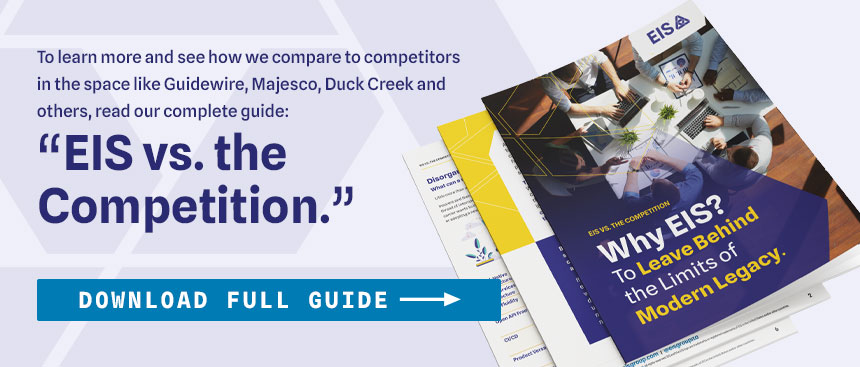To be clear: focusing on policy sales is not a bad thing.
However, when the policy is placed above the customer (whether in business priorities or in technology structure), things can start to go awry… The problem is when carriers prioritize maximizing policy sales and driving down operating costs above all or most other issues. When this happens, customer service almost always gets put on the back burner.
In contrast, being customer-centric is about maximizing the value of the customer by perfecting their experience. Basic examples include making it easier for policyholders to file claims or providing intuitive user interfaces through mobile insurance apps.
Though it’s not the be-all-end-all of the philosophy, an insurer’s tech setup plays a big role in customer-centricity.
The legacy and modern legacy core systems many insurers have used for so long are fine for policy-centric models, but they’re not great at empowering true customer centricity.
In this post, we’ll look at key reasons why policy-centricity is a disservice to your existing market (and future target audiences) and how you can change course with customer-centric coretech.
1. Out of Touch With the Times
When modern legacy core systems for insurance first hit the market about 25 years ago, they made sense for where the industry was at the time. They’d been built to support more efficient (and profitable) policy sales and administration, and that’s what carriers thought would maximize their success.
Though this issue existed across all insurance lines, traditional group benefits operations are a particularly good example: Policies were sold with a focus on the group rather than individual members, so technology platforms maximized the efficiency of that model.
Customers, meanwhile, had no reason to shop for (or enroll in) policies by doing anything other than comparing premium rates and coverage options.
Now, industries including retail, banking, and streaming entertainment offer personalized experiences. Customers expect the same from insurers, and are demanding it from carriers. They want policy-buying and adjustment tailored to their specific needs, web- or mobile-based claim filing and tracking, multiple digital payment options, easy personal data management, and more. (Going back to group insurance for a moment, members want to easily enroll in the group plan most suitable for them while choosing specific direct-to-consumer voluntary benefits — experiencing no hiccups or glitches in the process.)
Legacy core systems can’t easily support any of these options. The effort required to add such functions to an outdated core — i.e., a lot of IT work that’s intricate and time-consuming — is so resource-inefficient that it may invalidate the gains it’d otherwise help insurers achieve. Even if intelligent third-party point solutions integrate successfully, which isn’t guaranteed, problems with data exchange will impact performance and damage the customer experience.
This problem only gets solved with an upgrade to coretech capable of supporting the fluid, real-time customer data processing that’s necessary to power more personalized and intuitive experiences for policyholders.
2. Siloed, Disconnected Customer Data
When insurers stick to a policy-centric business model and the modern legacy technology that’s underneath it, data is often spread out across multiple databases and systems. This siloing separates customer data by function (policy admin, claims, billing) and also frequently means redundancies within the silos — e.g., a P&C customer with auto, home, and liability coverage having three different policy records.
To say nothing of the complications this creates for insurance business users, customers can go through nightmares trying to find a simple detail about their coverage. If they dial into their carrier’s call center or visit the customer-facing web portal, the presence of redundant data means it could be time-consuming and frustrating to find the right record for the right policy. Siloed and redundant data also means there’s a bigger risk of inaccuracies, and that can cause any number of problems down the line: delayed claims processing, overbilling, coverage gaps, and more.
With a core platform like EIS Suite™, this sprawl doesn’t happen. Customer profiles in CustomerCore™ give carriers a unified view of all policies, claims, bills, and other relevant interaction records across their entire history with the insurer.
3. Price-Led = Trouble-Bound
Because the policy-centric model is all about maximizing sales and reducing costs, it’s historically common for insurers that follow this approach to focus strongly on competitive pricing. As with other aspects of policy-centrism, you could make a reasonable argument in favor of a price-led model a couple of decades ago … but it makes much less sense now.
Why? Above all, it’s because quality customer experience has become a proven value generator for insurance in recent years, based on research by McKinsey. Someone choosing between two home policies won’t pick the cheaper one by default. If the pricier option comes with value-add features that simplify and streamline their insurance experience, they’re likely willing to pay a bit more than what they originally budgeted.
Meanwhile, if customers realize their current carrier can’t offer robust CX and ease of use — which isn’t possible with outdated core systems — they’ll start looking elsewhere for an insurer that can, even if this means spending more. Soon enough, carriers bound by legacy tech will start feeling the pain in their bottom line to a degree they can’t ignore.
Ready to Cure Policy-Centric Tunnel Vision?
Committing to a customer-centric direction — and the coretech that can support it — is an investment of both time and resources. But it’s also an investment in future-proofing your operations, by maximizing the value of every customer and building a foundation for their loyalty. Modern legacy core system vendors, meanwhile, will keep you stuck in the policy-centric past.
To learn more and see how we compare to competitors in the space like Guidewire, Majesco, Duck Creek, and others, read our complete guide: “EIS vs. the Competition.”





